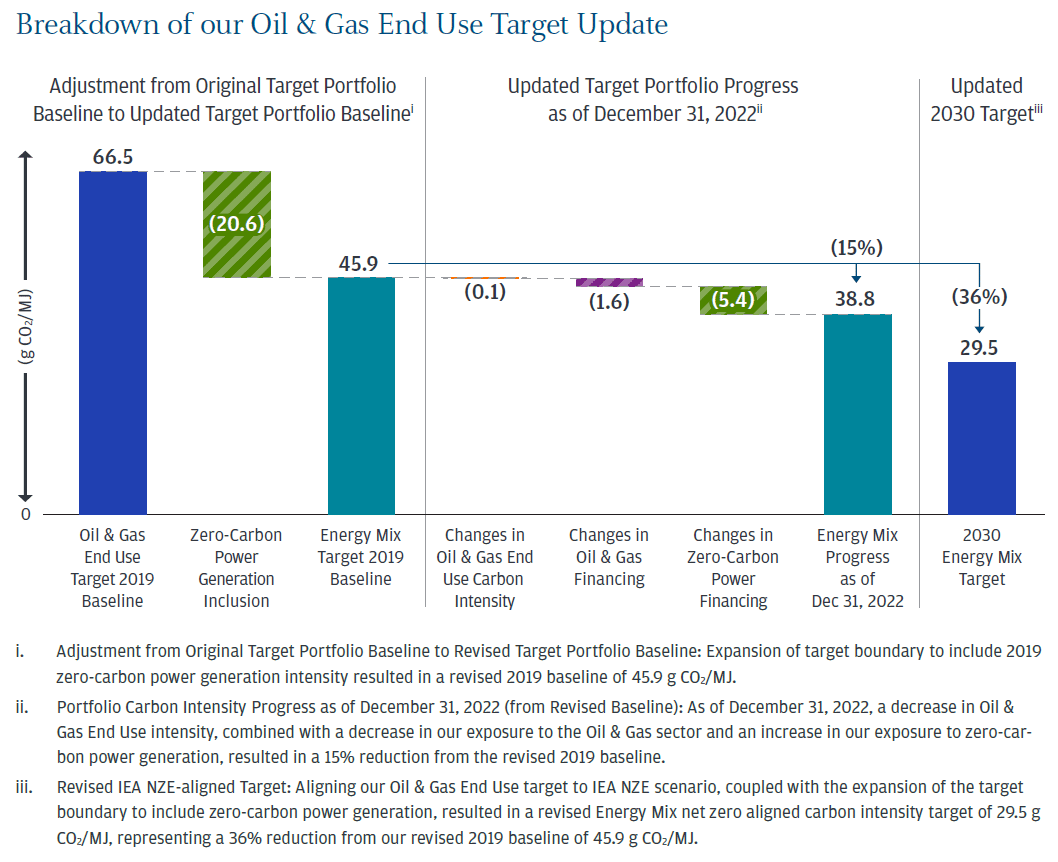JPMorgan Chase (JPMC) has decided that the best way to give the appearance of meeting its key financed emissions reduction target is to redefine the target. JPMC had previously set a target to reduce the intensity of the emissions resulting from the consumption of the oil and gas produced by the companies that it finances. It has now rebranded this target “Energy Mix” and folded into it the bank’s “zero-carbon” power finance. All JPMC’s targets are intensity based, so because Energy Mix includes more produced energy than the old target, its denominator (joules of energy) goes up, but its numerator (CO2) stays the same, and so its financed emissions appear to decline. This accounting trickery means that it should easily be able to meet its target of a 36% reduction in Energy Mix financed emissions intensity by 2030 without doing anything to reduce financing for oil and gas expansion.
JPMC is the world’s biggest bank outside of China in terms of the size of its assets (1). It has been the world’s biggest banker of fossil fuels — and the biggest banker of fossil fuel expansion — for six out of the past seven years (2). What it does on climate matters.
In May 2021, JPMC became the first big US bank to announce sectoral emission reduction targets, including for oil and gas end uses. While these targets were far from being “Paris-aligned” as JPMC claimed (3) they did go further than most of the bank’s competitors as they included the emissions resulting from not just their lending, but also from their capital market activities (meaning mostly bond issuances). JPMC reports 100% of the volume of its capital markets financing, and does not adjust it down by using a weighting factor as is done by Barclays and as has been proposed by the standard setting body, the Partnership for Carbon Accounting Financials (PCAF) (4).
It was encouraging to see JPMC announce in its new climate report (5) that it is:
- Updating its 2030 sectoral decarbonization targets to align with the IEA’s 1.5°C-aligned Net Zero Emissions (NZE) scenario (the targets were previously aligned with the IEA’s now obsolete 1.7°C Sustainable Development Scenario);
- Reporting absolute financed emissions for the nine carbon-intensive sectors for which it has now set targets (although the targets are still set in relative terms);
- Setting new NZE-aligned benchmarks for the methane emissions of its oil and gas clients (6); and
- Establishing new financed emissions intensity targets for shipping and aluminum.
The inconvenience of higher ambition
By aligning with the NZE scenario, JMPC has had to revise upward the ambition of its sectoral intensity targets. JPMC’s Oil and Gas End Use (OGEU) target, which was previously a 15% reduction, became a 29% cut. This is by far the most significant of JPMC’s targets: almost three-quarters of its absolute financed emissions across the nine sectors for which it discloses data come from the end uses of oil and gas (7).
Unfortunately such a step up in ambition seems to be a step too far for JPMC. The bank appears to believe that meeting this new target would require cutting its support for oil and gas clients that don’t do enough to reduce their emissions. JPMC wants to look like a responsible actor on climate by claiming to be 1.5°C aligned, while continuing its massive financing of fossil expansion.
JPMC has devised a carbon accounting trick that enables it to give the appearance of upping its ambition, while continuing with business as usual. It has rebranded its OGEU target as “Energy Mix” and then poured its “zero-carbon” electricity financing into its oil and gas bucket. JPMC’s “zero-carbon” electricity finance was and remains accounted for in the banks’ Electric Power financed emissions intensity target, and its Sustainable Development finance target. But now it does triple duty in also helping dilute the financed carbon dioxide emissions from its oil and gas lending.
The intensity of JPMC’s OGEU portfolio in its baseline year of 2019 was 66.5 gCO2/MJ. When the bank dilutes these emissions with clean power finance its Energy Mix intensity in 2019 drops by 31% (see Figure 1). The 2030 reduction target for Energy Mix is actually higher in percentage terms than it would have been had they kept the OGEU target: 36% versus 29%. However meeting the new target should be much less disruptive to JPMC’s energy bankers’ relationships.
The convenience of dodgy targets
The financing demands of the fast-growing power technologies JPMC defines as “zero-carbon” — renewables as well as green hydrogen and carbon capture and storage (8) — are likely to grow rapidly for the rest of this decade, especially in the bank’s largest markets in North America and Europe (9). So JPMC can keep its oil and gas clients, and appear to reduce these clients emissions by following the growing market for clean power.
Indeed, JPMC reports that it has already cut the financed emissions intensity of its Energy Mix portfolio by 15% in the three years after the end of 2019. The great bulk of this reduction comes from increased zero-carbon power finance (see Figure 1). JPMC attributes the small reduction in its OGEU financed emissions over this period to the oil and gas industry needing less external capital due to its windfall profits from high oil prices (10). If the Energy Mix financed emissions intensity continues dropping at the same rate it has for the past three years (roughly 5% per year), JPMC will exceed its 2030 target.
JPMC CEO Jamie Dimon states in his introduction to the bank’s climate report that “thoughtful, well implemented public policy” is needed to address climate change. This is certainly true. But financial institution policies also need to be thoughtful and well-implemented and JPMC is failing badly at meeting this standard. JPMorgan Chase can do better than this.




